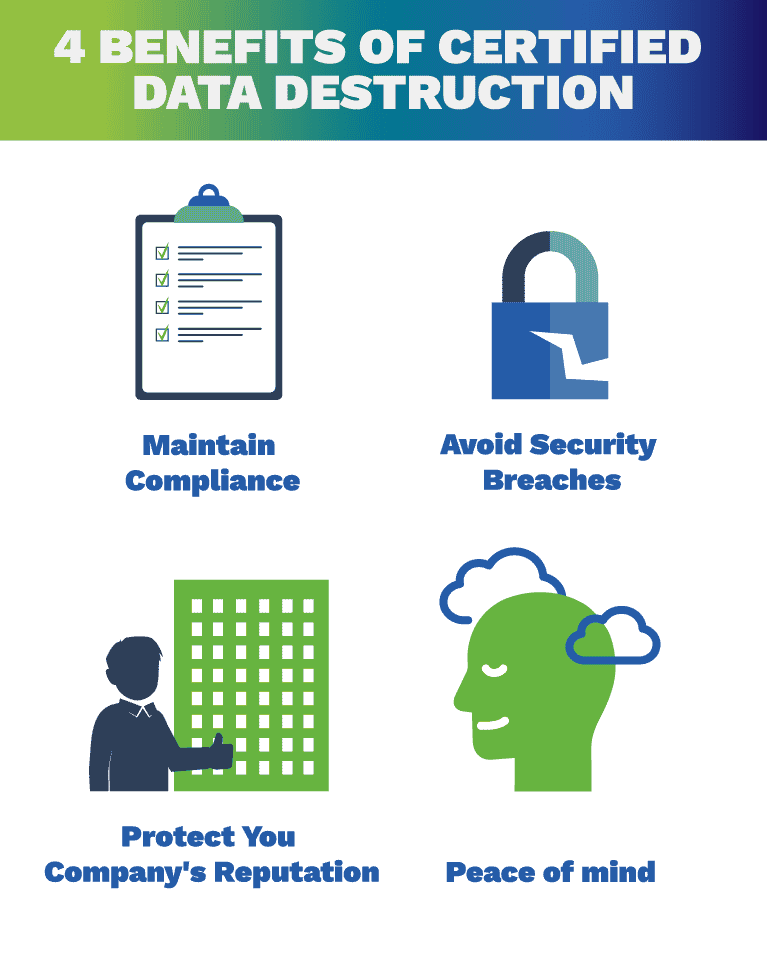How Robust Data Destruction Improves Your Overall Cyber Security Steps
Exploring the Importance of Data Destruction in the Context of Computer System Security Services and Protecting Confidential Information
In a period where data breaches are significantly common, the relevance of reliable data devastation can not be overstated. What methods can organizations carry out to enhance their information damage methods?
Understanding Data Devastation
Data devastation is an important element of computer system safety that includes the permanent removal of data from storage devices to avoid unauthorized accessibility and prospective data violations. In an increasingly electronic landscape, companies encounter enhanced dangers connected with delicate info being poorly accessed or manipulated. Reliable information destruction safeguards versus these threats, guaranteeing that confidential dataâEUR" such as client information, copyright, and financial recordsâEUR" can not be recovered after disposal.
Understanding the significance of data destruction extends beyond mere conformity with lawful and governing structures; it is crucial for keeping business honesty and depend on. When data is incorrectly handled or inadequately damaged, the effects can be extreme, including financial loss, reputational damages, and lawful obligations.

Techniques of Information Removal

One common technique is information cleaning, which entails overwriting existing information with arbitrary patterns multiple times. This technique makes the original data irretrievable, making it a prominent selection for companies looking for to shield personal information.
Another technique is degaussing, which utilizes an effective electromagnetic field to interfere with the magnetic domain names on storage space gadgets, efficiently removing the data. This method is particularly effective for magnetic media but is not appropriate to solid-state drives.
Physical destruction is an additional durable approach, crushing or involving the shredding of storage space gadgets. This technique guarantees that data recuperation is essentially impossible, making it optimal for extremely sensitive details.
Last but not least, file encryption can serve as a complementary strategy to information removal. By encrypting information before deletion, organizations can include an extra layer of protection, making sure that also if remnants are recuperated, they remain hard to reach without the decryption trick. Each method ought to be picked based on the degree of information level of sensitivity and the certain protection requirements of the company.
Legal Compliance and Information Safety And Security
Organizations must browse a complex landscape of lawful requirements connected to data protection, particularly after implementing techniques of data elimination. Various guidelines, such as the General Information Defense Law (GDPR) and the Health And Wellness Insurance Mobility and Liability Act (HIPAA), impose rigid standards on exactly how companies must dispose and manage of sensitive data. Failing to adhere to these guidelines can bring about significant legal effects, including considerable penalties and reputational damages.
Data damage procedures have to be carefully recorded to show conformity with applicable legislations and requirements. This documents not just functions as proof of adherence to legal responsibilities however additionally highlights a dedication to safeguarding sensitive information. Organizations ought to likewise develop clear plans relating to information retention and devastation timelines, making certain that data is not held longer than required.

In addition, regular audits and assessments of data destruction practices are necessary to keep compliance and adjust to progressing legal frameworks (data destruction). By proactively addressing lawful needs, companies can reduce risks related to information breaches and demonstrate their dedication to information safety and security. Ultimately, focusing on legal compliance in information damage processes is not simply a regulative obligation, yet a basic facet of a robust data protection method
Influence on Service Online Reputation
The reputation of an organization can be dramatically impacted by its approach to information devastation and monitoring. In today's digital landscape, where data violations can happen anytime, the failure to effectively take care of sensitive information can cause serious repercussions. Organizations that inadequately manage information damage threat subjecting confidential consumer info, which not just breaches privacy legislations however also wears down trust fund among customers and stakeholders.
A tarnished online reputation can result in lowered customer loyalty, as customers become reluctant to engage with a service that has demonstrated oversight in safeguarding their information. Additionally, adverse promotion bordering a data breach can have a lasting effect, as possible customers may be prevented by the regarded absence of safety. This can lead to a direct decline in revenue and market share.
Furthermore, companies that prioritize data damage as part of their safety Look At This and security technique can improve their credibility by showcasing their commitment to protecting sensitive information. By adopting stringent data monitoring methods, organizations can not only mitigate threats however additionally place themselves as reliable entities in their particular markets, thus strengthening their overall brand name photo.

Finest Practices for Secure Disposal
Executing best methods for safe and secure disposal of information is vital for reducing threats connected with data violations and making sure compliance with personal privacy policies. Organizations needs to embrace a comprehensive information disposal policy that lays out procedures for both electronic and physical data devastation.
For physical data storage space devices, such as tough drives, shredding or degaussing is recommended to avoid data recuperation. Furthermore, companies ought to keep a chain of custodianship documentation throughout the disposal procedure, guaranteeing liability and traceability of disposed items.
For electronic information, using software application that complies with market criteria for data wiping is vital. This software must overwrite existing information multiple times, making healing basically impossible. It is also crucial to validate the effectiveness of the data damage procedure via audits or third-party assessments.
Training workers on safe and secure disposal practices adds one more layer of safety, as human mistake can often result in information direct exposure. Consistently reviewing and updating disposal plans makes sure placement with evolving regulations and technological developments. By carrying out these finest techniques, companies can dramatically lower the threat of unapproved information gain access to and improve their general data security technique.
Final Thought
Finally, data damage is an essential aspect of computer helpful site security services that guarantees the protection of secret information from unapproved accessibility. Carrying out efficient techniques of data eradication, sticking to lawful compliance, and recognizing the impact on organization online reputation are necessary elements of an extensive data protection i thought about this method. By adopting best techniques for safe disposal, organizations can cultivate depend on with clients and guard delicate data, inevitably adding to a more safe and secure digital landscape.
In a period where information breaches are significantly typical, the significance of reliable data devastation can not be overstated.Information damage is a critical part of computer protection that involves the irreversible elimination of information from storage gadgets to prevent unapproved access and possible information breaches. Organizations must also establish clear plans relating to information retention and destruction timelines, making certain that data is not held longer than needed.
By proactively addressing legal needs, organizations can reduce threats associated with data violations and demonstrate their commitment to information security (data destruction). Eventually, focusing on lawful compliance in data damage procedures is not just a regulatory responsibility, yet a fundamental element of a durable information security technique